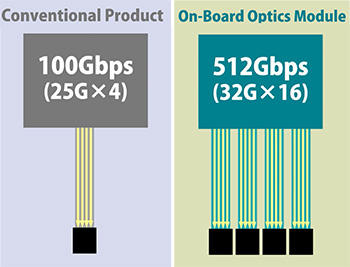Kyocera's prototype module is miniaturized for installation on a printed circuit board near the processor, allowing electronic data to be converted into optical signals instantaneously. In addition, the product is designed to create unprecedented improvements in signal-to-noise ratio, virtually eliminating the signal loss caused by conventional electrical conductors. As a result of these technological advances, Kyocera's On-Board Optics Module has achieved world-record bandwidth of 512 gigabits per second (Gbps)* and is expected to help data centers and supercomputers save power while increasing bandwidth and data transfer rates.
*512Gbps bandwidth is currently the world record using the Peripheral Component Interconnect Express 5.0 (PCIe gen5) extended interface standard (Kyocera research, September 2022).
■ Video: Introducing Kyocera's New On-Board Optics Module
https://www.youtube.com/watch?v=BxofLof8Rmc

Kyocera's New On-Board Optics Module
■ Development Background
AI, IoT, and expanding 5G communication services are creating a rapid increase in internet traffic worldwide and unprecedented demand for high-speed, large-bandwidth data centers. However, the data center industry is fast becoming a leading consumer of electricity, so reducing their power consumption is also a major issue for society.
Kyocera's new on-board optics module features a miniaturized form factor that can be board-mounted inside the server near the processor, enabling power-saving signal transmission by converting electronic data into optical signals instantaneously. In addition, the prototype's transmission bandwidth of 512 Gbps will substantially improve data center speed and capacity.
In the future, to support innovations like autonomous driving and the metaverse, more data centers will need to be built to reduce latency and shorten the distance to end-users. This module contributes to miniaturization by achieving high speed and large capacity in a small form factor, allowing data centers to be built in urban and other higher-population-density areas.
■ Prototype Product Features
1) Power Savings
Copper conductors are usually needed to send and receive electrical signals; however, even the best copper conductors introduce electrical resistance that results in signal loss. Kyocera's new on-board optics module converts the electrical signal from the processor into a low-loss optical signal on the circuit board. In addition, data can be received as optical signals until just before reaching the processor, further reducing signal loss and power consumption.

2) World-Record Bandwidth, Larger Capacity
The largest bandwidth among on-board optics on the market today is 100 Gbps; Kyocera's module achieves a world-record 512 Gbps bandwidth, over 5x greater than conventional products. Such large bandwidth is possible because the module uses a Low-Temperature Co-fired Ceramic (LTCC) mounting substrate developed by Kyocera, which offers exceptional material characteristics, such as fine wiring, low dielectric constant, multilayering, and thermal conductivity.

Kyocera's module measures just 43.5 x 30 x 8.1 mm, allowing world-record 512 Gbps bandwidth for high-capacity data transmission even in a limited space. This will help customers build faster, more space-efficient data centers.
■ Overview of Kyocera's On-Board Optical Module
| Bandwidth | 16 channels of 32 Gbps/channel, 512 Gbps total optical transmission and reception |
| Size | 43.5 x 30.0 x 8.1 (mm) (except 4 pairs of fiber-optic arrays) |
| Electrical Interface | High-speed, high-density connector plugs for connecting power and signal wires are mounted on the back. |
| Optical Interface | Four sets of 8-channel multimode optical fibers, each 4-channel optical transmission, and reception |
| Power Consumption | 9W, equivalent to 18 mW/Gbps |
| Reliability Assurance | Telcordia GR -468 - CORE compliant |
■ Future Development
Kyocera will continue to test our On-Board Optics Module technology with partner companies to achieve commercialization as early as possible. In addition, we will continue to engage in R&D to develop new products that contribute to solving the challenges of today's ever-evolving digital society.





